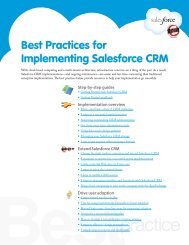Database.com Metadata API Developer's Guide - Salesforce.com
Database.com Metadata API Developer's Guide - Salesforce.com
Database.com Metadata API Developer's Guide - Salesforce.com
Create successful ePaper yourself
Turn your PDF publications into a flip-book with our unique Google optimized e-Paper software.
Chapter 2Quick StartThe easiest way to access the functionality in <strong>Metadata</strong> <strong>API</strong> is to use the Force.<strong>com</strong> IDE or Force.<strong>com</strong> Migration Tool. Thesetools are built on top of <strong>Metadata</strong> <strong>API</strong> and use the standard Eclipse and Ant tools respectively to simplify the task of workingwith <strong>Metadata</strong> <strong>API</strong>. Built on the Eclipse platform, the Force.<strong>com</strong> IDE provides a <strong>com</strong>fortable environment for programmersfamiliar with integrated development environments, allowing you to code, <strong>com</strong>pile, test, and deploy all from within the IDEitself. The Force.<strong>com</strong> Migration Tool is ideal if you want to use a script or a <strong>com</strong>mand-line utility for moving metadata betweena local directory and a <strong>Database</strong>.<strong>com</strong> organization. For more information about the Force.<strong>com</strong> IDE or Force.<strong>com</strong> MigrationTool, see developer.force.<strong>com</strong>.However, the underlying calls of <strong>Metadata</strong> <strong>API</strong> have been exposed for you to use directly, if you prefer to build your ownclient applications. This quick start gives you all the information you need to start writing applications that directly use <strong>Metadata</strong><strong>API</strong> to manage customizations for your organization. It shows you how to get started with File-Based Development. For anexample of CRUD-Based Development, see Java Sample Code for CRUD-Based Development.PrerequisitesMake sure you <strong>com</strong>plete these prerequisites before you start using <strong>Metadata</strong> <strong>API</strong>.• Create a development environment.It is strongly re<strong>com</strong>mended that you use a test database for development.• Identify a user that has the “<strong>API</strong> Enabled” and “Modify All Data” permissions. These permissions are required to access<strong>Metadata</strong> <strong>API</strong> calls.• Install a SOAP client. <strong>Metadata</strong> <strong>API</strong> works with current SOAP development environments, including, but not limitedto, Visual Studio ® .NET and the Force.<strong>com</strong> Web Service Connector (WSC).In this document, we provide Java examples based on WSC and JDK 6 (Java Platform Standard Edition DevelopmentKit 6). To run the samples, first download the latest force-wsc JAR file and its dependencies (dependencies are listed onthe page when you select a version) from mvnrepository.<strong>com</strong>/artifact/<strong>com</strong>.force.api/force-wsc/.Note: Development platforms vary in their SOAP implementations. Implementation differences in certaindevelopment platforms might prevent access to some or all of the features in <strong>Metadata</strong> <strong>API</strong>.Step 1: Generate or Obtain the Web Service WSDLs for Your OrganizationTo access <strong>Metadata</strong> <strong>API</strong> calls, you need a Web Service Description Language (WSDL) file. The WSDL file defines the Webservice that is available to you. Your development platform uses this WSDL to generate stub code to access the Web serviceit defines. You can either obtain the WSDL file from your organization’s <strong>Database</strong>.<strong>com</strong> administrator, or you can generate ityourself if you have access to the WSDL download page in the <strong>Database</strong>.<strong>com</strong> user interface. For more information aboutWSDL, see http://www.w3.org/TR/wsdl.5
















